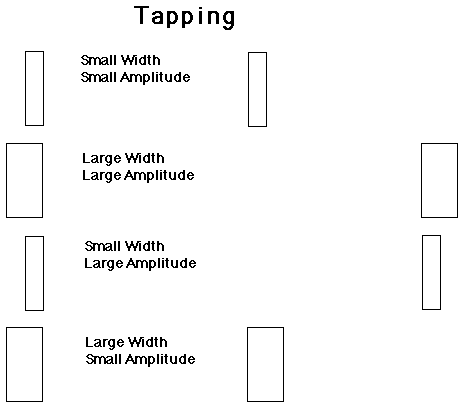
CMSC 434 - Spring 2008
Prof Bederson
Introduction to Human-Computer Interaction
Perform the following experiment.
Fitts' Law by design predicts a movement time. Typically, these times are less than one second for a graphical interface. Attempting to measure these sub-second movement times using stopwatches would probably lead to a great deal of error, so this experiment instead measures the errors committed by the particpants.
Using a metronome (online version available at (www.metronomeonline.com), a steady tempo is established so that the participants can hear each beat. A metronome is a device musicians use to set the tempo of a piece of music -- metronomes click at a certain steady rate, say 160 beats per minute. The individual participants are instructed to tap the point of a pen between two targets on a sheet of paper at the tempo of the metronome. After 30 seconds, the participants stop tapping and count the number of marks left by the pen outside the targets. The number of errors each participant made should be predicted by the Index of Difficulty in Fitts' Law.
It is important to stress to the participants that the goal is to make a tap at each click of the metronome without regard to errors (taps outside the targets). Accuracy is secondary to keeping up with the metronome.
Method:

Analysis:
Collect and average the number of errors across participants for each combination.This experiment should demonstrate that the Index of Difficulty predicts the difficulty of the task, and thus predicts the number of errors. The Index of Difficulty is

Clearly summarize your results, and describe how closely the formula predicted your results. In particular, you must at least report the following:
List the steps in terms of the three components of HIP needed for a person to answer the above problem. For each step, briefly describe what is happening at that step. Summarize the number of each of the three components.
(20 points) Are the following statements true or false? Briefly (2 or 3 sentences) explain your answer in terms of learning theory.
Even though people learn to write with their dominant hand, they can write their name with a paintbrush held in their mouth.
In a driving range golfers practice aiming at targets placed at fixed distances (e.g., 75 yards, 150 yards). It is very unlikely that they will encounter these specific distances during the game. Yet practicing on the driving range improves one's ability to play in actual games with targets at varying distances.
(20 points) You are standing in front of a large concrete wall. Right next to you, a friend is blowing a horn creating a short pulse of sound every 5 seconds. What is the closest you and your friend can be from the wall so that you perceive an echo? Explain your answer. (you can assume that the speed of sound is 330 m/s).
Turn-in: Send your homework to the TA in PDF, DOC, or RTF format by email before class on the due date with the text "CMSC 434-hw5" in the subject line.